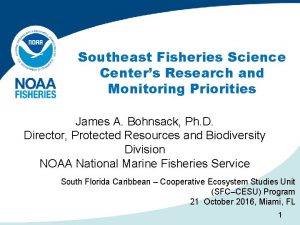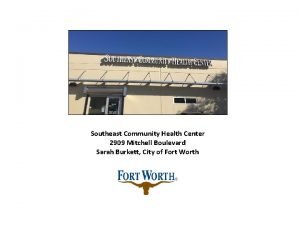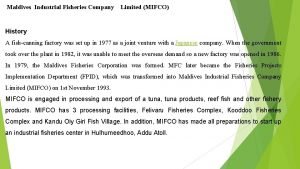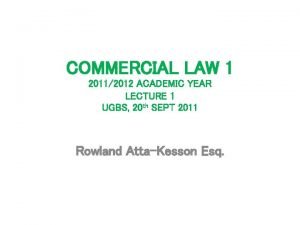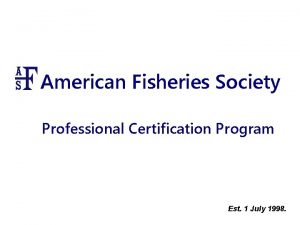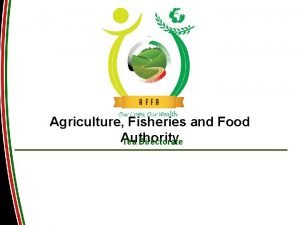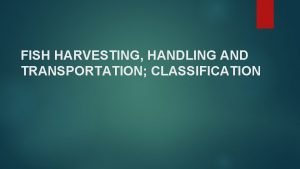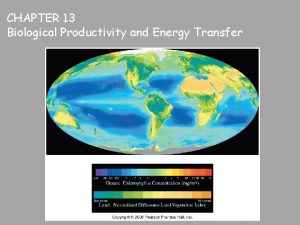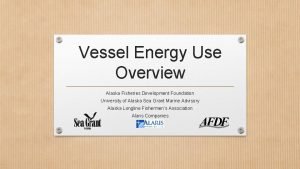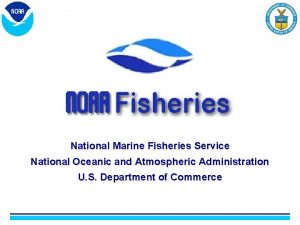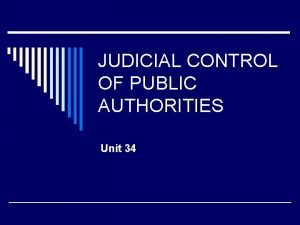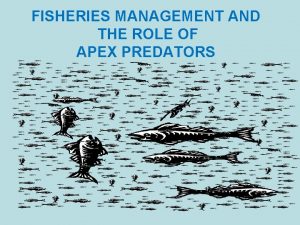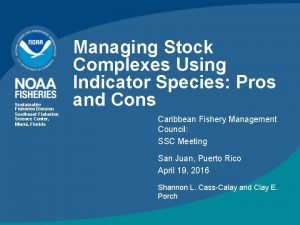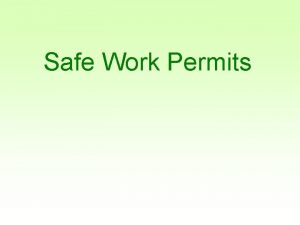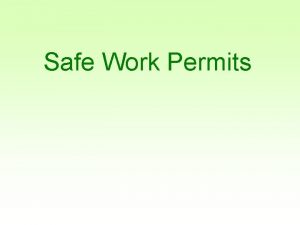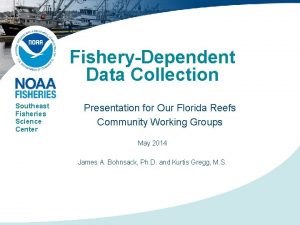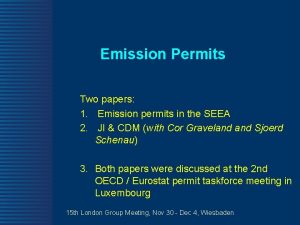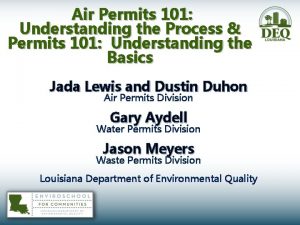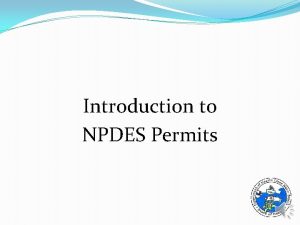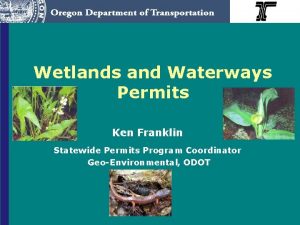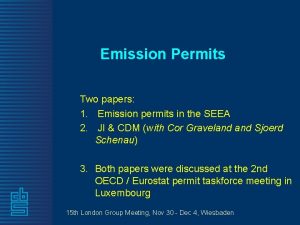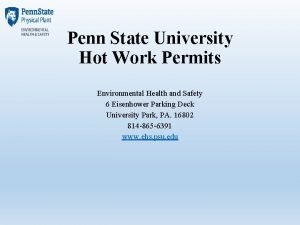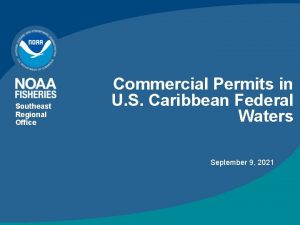Southeast Fisheries Science Center Hot Work Permits Hot



















![TEST [True or False] Print Your Name Here 1. Examples of hot work include: TEST [True or False] Print Your Name Here 1. Examples of hot work include:](https://slidetodoc.com/presentation_image_h2/147e5e55f8029c2d8b57473a8ac1d1dc/image-20.jpg)


- Slides: 22

Southeast Fisheries Science Center Hot Work Permits

Hot Work Goals and Objectives: § At the end of this program you will: - Recognize work that requires the use of Hot Work Permits. - Be familiar with and able to implement the SEFSC Hot Work Permit Process.

What is Hot Work? Definition: § Hot Work is any work using open flames or sources of heat that could ignite materials in the work area.

Hot Work § Examples of hot work are: - welding burning brazing propane soldering oxyacetylene cutting grinding ferrous metals torch applied roofing

Hot Work Why Hot Work Permits? § Every year fires related to hot work activities occur causing significant property damage and business interruption. Many of these fires could have been prevented if employees and contractors had used appropriate fire prevention measures while conducting hot work. § During a recent 5 year period FM Global reported that after Arson and Housekeeping, Hot Work was the third leading cause of fires in FM insured properties with an average fire loss totaling $1. 4 million dollars per incident. § SEFSC requires the use of the Hot Work Permit system as a primary tool for preventing the outbreak of fire due hot work operations.

Fire Potential § Heat Source Temp * § Ignition Temp * § § § Electric Arc Welder : 10, 900ºF O 2 / Acetylene Torch : 6, 330ºF Propane Torch : 3, 595 F Welding Torch Slag : >2, 000ºF Electric Heat Gun : 600 – 1, 350ºF § Radial Metal Cut Saw : >1, 000ºF § Wheel Grinder : 1, 000ºF § § § § Styrene : 914ºF Typical Asphalt : 905ºF Polyurethane Foam : 824ºF Lubricating Oil : 500 - 700ºF Mineral Spirits : 473ºF Wood Products : 380 - 800ºF Corrugated Paper : 380 500ºF * Information provided by FM Global

Is Hot Work Necessary? ? Question to Ask: Can the job be avoided or is there a safer way? § Before beginning any hot work, ask yourself if the work can be done a safer way. Hot work is potentially very hazardous and should be avoided if not absolutely necessary.

Work that may not require the use of a hot work permit includes: Areas that are maintained and identified as: - Welding Shops - Maintenance shops with designated areas for hot work activities - Work on equipment (ex. Farm Implements) occurring in areas outside of buildings where the potential for fire development is minimal.

Starting the Process Procedures: Before beginning hot work a hot work permit must be completed. Permits can be obtained from your supervisor or the SEFSC Environmental, Safety & Health Web Page.

Hot Work Permit Valid Only for Day Issued Date: October 16, 2004 Bldg. : Main bldg. Floor: First floor, west side of bldg. Description of Job: Welding bldg. stand pipe The above location has been examined. The precautions checked on the reverse of this card have been taken to prevent fire. Permission is granted for this work. Signed: I. Lovemyjob Permit Expires: Date: Time Started: 9: 00 am 10/16/04 Time: 5: 00 pm Time Finished: 11: 30 am Final Checkup Work area and all adjacent areas to which sparks and heat have spread (such as floors above and below and on opposite side of walls) were inspected for at least 30 minutes after the work was completed and found fire free. Signed: I. Lovemyjob After signing, return permit to facility individual responsible for Hot Work Safety. Maintain in files for a period of 3 years. [FRONT SIDE} Permits are issued for the specific job being done, and for a specific time period. The time period is usually for the working shift, but may never exceed twenty-four hours. Completed Permits need to be displayed in the hot work area.

Hot Work Safety Precautions REQUIRED PRECAUTIONS Before signing this card the individual responsible for Hot Work Safety should inspect the work area and check below the precautions taken. � � � � Fire suppression system/extinguishers available and operable. Hot work equipment is operable and in good repair. Smoke / fire detectors in the immediate area of the hot work have been temporarily disabled until work is complete. Precautions within 35’ of Hot Work Floor swept clean of combustibles. Flammable liquids removed, combustibles protected with welding drop cloths or shields. Combustible flooring wet down or covered with damp sand, welding drop cloths or shields. All wall and floor openings covered. Fire resistant tarpaulins suspended beneath work. Precautions within 50’ of Hot Work Compressed gas cylinders moved from area or protected. Work on Walls or Ceilings Construction is noncombustible. Combustible moved away from other side of wall. Work on Enclosed Equipment (Tanks, Barrels, etc. ) Tanks, drums, or barrels have been cleaned and purged of flammables and toxics. Tank feeds are locked out and the tank is vented. Fire Watch Building occupants have been protected or isolated from the hot work area. Fire watch provided during and for 30 minutes after work. Fire watch trained in use of fire suppressants and alarms. [BACK SIDE] The employee performing the Hot Work has the responsibility to verify that all necessary precautions have been taken at the worksite.

Safety Precautions (cont’d) Are Fire Suppression Sprinklers in service ? Welding and other hot work have been found to be a leading cause of fires in industry. Sprinkler systems should remain in service in the hot work area, unless specifically approved by the facility manager. If a sprinkler system needs to be taken out of service specific procedures must be followed.

Safety Precautions (cont’d) Is cutting and welding equipment in good repair ? § Gas hoses, backflow preventers, fire resistive tarpaulins, curtains and other cutting and welding equipment must be maintained in good repair.

Safety Precautions (cont’d) Anything that can burn must be removed or protected from the immediate work area. Requirements within 35 feet: � Floor swept clean of any combustible debris. � Flammable and ignitable materials and debris have been moved at least 35 feet from the hot work area or covered and protected with fire resistant materials. � Cracks or holes in floors, walls and ceilings (including ductwork) are covered or plugged. � Combustible floors covered with fire-resistive material Requirements within 50 feet: � Explosives, compressed gas cylinders or stored fuel have been moved at least 50 feet from the hot work area or have been protected from the hot work. Work on walls or Ceilings � Construction is noncombustible and has no combustible covering or insulation. � Areas adjacent to walls being worked on are checked for combustibles and any combustibles are either removed or protected.

Fire Watch � Fire watch will be provided during and for at least 30 minutes after work, and during any coffee or lunch breaks. � Fire watch is supplied with suitable extinguishers, or charged small hose. � Fire watch is trained in use of this equipment and in sounding alarm. Fire Watch Personnel's main responsibility is to monitor the area for the possible development of fire from the hot work. Other job tasks can be performed as long as they are able to adequately monitor the area for potential fire. § Fire Watch Personnel must be trained to use fire extinguishers or other fire extinguishing equipment that is present. § Fire Watch Personnel must be aware of how to report emergencies and to activate building fire alarm systems. § Fire Watch Personnel must be identified and their qualifications verified prior to commencing hot work.

Hot Work Completion Final Checkup: Work area and all adjacent areas to which sparks and heat have spread (such as floors above and below and on opposite sides of walls) were inspected for at least 30 minutes after the work was completed and found free of fire. Signed: I. Lovemyjob After signing, return the permit to the facility individual responsible for Hot Work Safety. Maintain in facility files for a period of 3 years. This Permit is Valid Only for the Day Issued Before leaving the area, verify that no smoldering fires have developed within walls, cracks in floors, or in ceiling areas where you have been working. Return the Hot Work permit to your supervisor to sign and maintain for 3 years.

Summary § All employees expected to perform hot work must be familiar and trained in Hot Work Procedures. § Jobs like electric arc welding, brazing, gas soldering, oxygen-acetylene cutting, welding and torch applied roofing work may require the use of a hot work permit. § Permits are issued for a specific job and for a specific time frame. § All necessary equipment must be on site and in good working order before work begins.

Summary (cont’d) § A fire watch must be present for the duration of hot work and for at least 30 minutes after work is completed. § A fire inspection must be conducted by the person doing the hot work before leaving the job site. § Completed Permits are to be returned to maintained in facility files for 3 years. § By following safe hot work practices and procedures you will help maintain a fire safe environment for the SEFSC.

Resources § To view the entire SEFSC Hot Work Program click here INSERT LINK HERE § If you have any questions concerning Hot Work procedures contact: § § Facility Manager, Engineering/Maintenance Department, Area Safety Representative, or the Safety & Environmental Compliance Officer listed below. Dan Poulos 850/234 -6541 ext. 237 Dan. Poulos@noaa. gov
![TEST True or False Print Your Name Here 1 Examples of hot work include TEST [True or False] Print Your Name Here 1. Examples of hot work include:](https://slidetodoc.com/presentation_image_h2/147e5e55f8029c2d8b57473a8ac1d1dc/image-20.jpg)
TEST [True or False] Print Your Name Here 1. Examples of hot work include: welding; burning; propane soldering; oxyacetylene cutting; grinding ferrous metals; and torch applied roofing. 2. Fires can be prevented if fire prevention measures are used during hot work activities. 3. Certain work areas that may not require the use of a hot work permit include welding shops and designated areas within maintenance shops. 4. Hot work permits may be issued for numerous jobs as long as they consist of the same type of hot work (e. g. welding at various locations throughout the facility). 5. Supervisors are responsible for verifying that all necessary precautions have been taken at the worksite.

TEST cont’d 6. Anything that can burn must be removed or protected from the immediate (within 35’) hot work area. 7. It is permissible to leave compressed gas cylinders or fuel unprotected as long as they are not within 35’ of the hot work area. 8. The Fire Watch individuals main responsibility is to monitor the hot work area for possible development of fire and to respond accordingly in its event. 9. Fire Watch personnel are not required to, but should, be trained in the proper use of a fire extinguisher. 10. Thirty minutes after the completion of any hot work, and before leaving the hot work area, you must verify that no fires have developed within walls, cracks of floors, or the ceilings.

TEST KEY 1. True 2. True 3. True 4. False 5. False 6. True 7. False 8. True 9. False 10. True Employees maintain completed test in your files
 Southeast fisheries science center
Southeast fisheries science center Southeast community health center
Southeast community health center Why science is your favourite subject
Why science is your favourite subject Mifco logo
Mifco logo Wilson v brobbey
Wilson v brobbey Certified fisheries professional
Certified fisheries professional сплит institute of oceanography and fisheries
сплит institute of oceanography and fisheries Small-scale fisheries
Small-scale fisheries Dg fisheries
Dg fisheries Agriculture fisheries and food authority
Agriculture fisheries and food authority Northwest fisheries
Northwest fisheries Classification of fisheries
Classification of fisheries Institute of oceanography and fisheries
Institute of oceanography and fisheries Ocean fisheries
Ocean fisheries Ocean fisheries
Ocean fisheries Microscopic algae
Microscopic algae Alaska fisheries development foundation
Alaska fisheries development foundation General fisheries commission for the mediterranean
General fisheries commission for the mediterranean National fisheries service
National fisheries service Ministry of food agriculture and fisheries denmark
Ministry of food agriculture and fisheries denmark Allingham v minister of agriculture and fisheries
Allingham v minister of agriculture and fisheries Boat security system
Boat security system Tiger shark torpedo
Tiger shark torpedo
